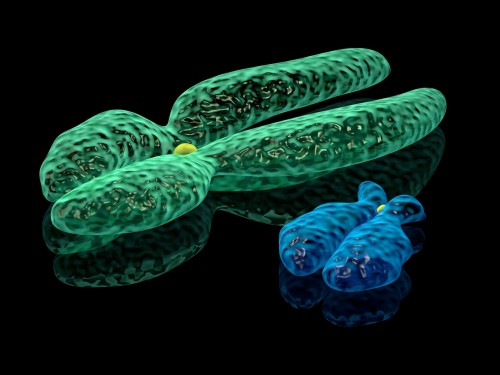The X chromosome and the Y chromosome were identical, until the Y chromosome began to diverge from the X chromosome in males. It also shrunk in such a way that today it contains only 20 genes compared to over a thousand in the X chromosome

man or woman? Male or female? In humans and other mammals, the difference between the species depends on a single element in the genome - the Y chromosome.
It is present only in males who have one X chromosome and one Y chromosome while females have two X chromosomes. Thus, the Y chromosome is solely responsible for all the morphological and physiological differences between males and females.
However, this was not always the case. The X chromosome and the Y chromosome were identical, until the Y chromosome began to diverge from the X chromosome in males. It has also shrunk in such a way that nowadays it contains only 20 genes compared to the X chromosome which contains over a thousand genes). When was the original Y chromosome first formed, and what genes were retained? The answer was discovered by a team led by Henrik Kissman, assistant professor at CIG and group leader at the Swiss Institute for Bioinformatics, and colleagues from Australia. They revealed that "genitals" appeared in mammals 180 million years ago.
In the same topic on the science website:
- The ancestor of the herbivores was discovered
- The chromosome stays in the family
- The Y chromosome survey showed: cheating is less common than thought
By studying samples from several tissues of males, in particular from testes of different species, the researchers were able to reconstruct the Y chromosome genes from three lineages of mammals: marsupials (which include humans, great apes, rodents and elephants), marsupials (such as opossums and kangaroos), and bivalves (Egg-laying mammals such as the duck and the echidna (a type of Australian hedgehog). In total, the researchers compared 15 mammals from all three lineages, as well as chickens, which they included in the study for comparison.
Instead of sequencing all the Y chromosomes, which would have been an enormous task, according to Diego Cortez, the lead researcher on the study from CIG, the researchers proposed a shortcut. "By comparing the genetic sequence between male and female tissues, the researchers eliminated the identical genes and kept only those that were unique to Y chromosomes. In doing so, they built the atlas of all male chromosome genes to date."
The research required over 29,500 computer hours, a huge task that could not have been carried out without an important technical tool: genomic sequencing of the genomic platform at the Center for Integrative Genomics while making the most of the resources of SIB's high-performance computing center for biological analysis.
Two independent genes that determine the genes
The study showed that the same gene that determined the species, known as SRY in shrews and marsupials, was created in the common ancestor of the two lineages about 180 million years ago. Another gene, AMHY, which is responsible for the appearance of the Y chromosome in bibs, appeared 175 million years ago. The two genes that according to Gisman are involved in the development of the testicles, appeared almost at the same time, but in a completely independent way.
The nature of the sex determination system that existed in the ancestor of all mammals still remains open, given the fact that the Y chromosome did not yet exist at that time, at least not in the studied lineages, so how was the sex of the newborn determined before that? Was this determination made by other chromosomes or by environmental factors such as temperature differences? This scenario is not unreasonable, given the fact that temperature determines the species of crocodiles. "As far as mammals are concerned, the question remains open," says Cortez.
